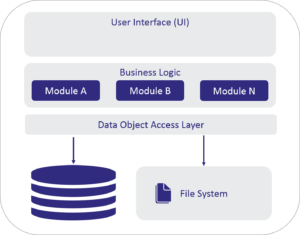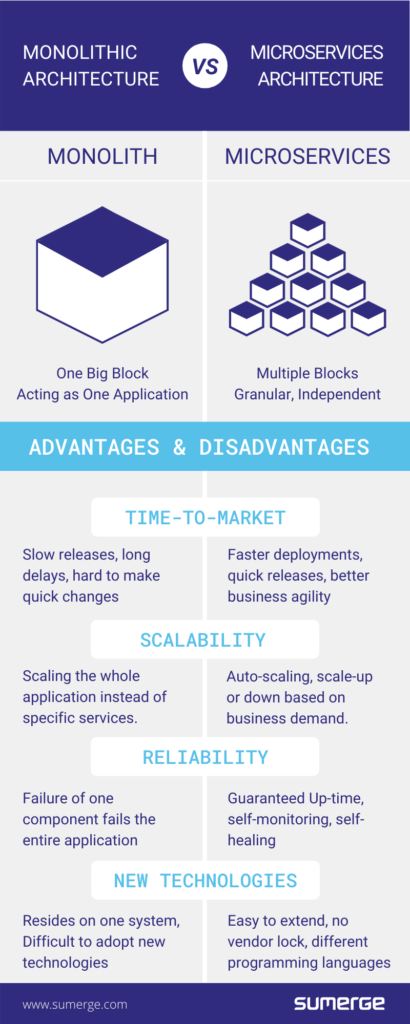
Microservices vs. Monolithic Architecture
- Posted by Adham Jan
- On November 16, 2020
When you hear the term “Microservices,” you often hear it in conjunction with the word “Monolithic,” when talking about software design. You may wonder why these words are often mentioned together and what the difference is between them. Software architecture based on microservices has more resiliency and better business agility than monolithic designs, but why is that? We’ll explore more about Microservices vs Monolithic Architecture.
 |
Featured E-BookTime-To-Market Driven Disruption Starter Guide to Microservices and Business AgilityThis e-book brings you a holistic approach into beginning your microservices transformation journey. |
What Is Monolithic Architecture?
When talking about software design, the traditional culture was to create an app from a single design that was built in one piece. We call this a “monolithic” design because although the app might be modular, it still has to be run as one large block. Monolithic design usually encapsulates the User Interface (UI), the Data or Database Interface, and the Business Logic, or the “guts” of what the software does.

Advantages of Monolithic Architecture
Designing your software in a monolithic design has some merits. It is the traditional way software has been designed in the past, and many “old timers” in the software industry may actually prefer it over using microservices. Some of the positives of going with monolithic design include:
- Lack of complexity — Monolithic designs may be modular and complex, but they often do not have the complexity that microservices architecture may have.
- Simple to deploy — Monolithic designs only require the release of the one app that has everything within it.
- Simple to test — Monolithic architecture is relatively simple for testers to test. It has certain interfaces that must return expected values. If the software fails to return expected results, it fails; if it returns expected results, it passes.
Disadvantages of Monolithic Architecture
Despite the positives to using monolithic architectures, there are plenty of drawbacks to using them. These include:
- Difficult to modify — Often monolithic architectures require changes that affect more than one component within the software. That makes it difficult to change without affecting other parts of the software, most of the time, negatively.
- Difficult to fully understand — Monolithic architectures often grow in complexity to the point where it is hard for other engineers and programmers to learn.
- Drag on start-up time and resources — Monolithic software is designed to obtain all its resources at start-up, thus creating significant lag-time.
- Reliability is suspect — Quite often this type of architecture doesn’t have the resiliency that microservices have. The result is memory leaks, bugs, and other problems that will bring down the entire app should there be a point of failure that hasn’t been detected.
- Not agile — Modification of monolithic software is difficult, if not impossible, to the business’s changing needs. It does not have business agility and frequently has long delays in time-to-market. It doesn’t have the scalability that other types of architecture does. To modify it requires an extensive overhaul.
- Difficult to adopt new technologies — Because monolithic software often resides on one system, it is often difficult, if not impossible, to adopt new technologies.Your DevOps team may have to scrap the software and start from scratch, or at least consider a major overhaul.
What is Microservices Architecture?
Now that you’re aware of what a monolithic architecture is, let’s look at what a microservices architecture is and how it differs. Microservices architecture is a distributed form of software where each task or microservice is encapsulated in its own program. In other words, instead of have one gigantic monolithic piece of software, you have multiple, tiny pieces of software that together do the same thing. Hence, the term “microservice.” The difference is that each microservice has its own task and is able to talk to other microservices within the overarching app. Because microservices are, in themselves, doing their own work, it doesn’t matter what platform they’re on or if they’re on one platform or many. The microservices provide the business agility between the User Interface and the database that is often missing in monolithic designs.

Advantages of Microservices Architecture
There are many benefits to using a microservices architecture over a monolithic architecture. Here are some of the benefits:
- Easy to Modify — Microservices by their very nature are small and easy to understand. Because their tasks are encapsulated, modifications to the overall design is simplified.
- Easy to Understand — Because the architecture is broken down into simpler components, each microservice is easy to understand.
- Little drag on start-up time and resources — Unlike monolithic software, microservices require that only the services needed will start first. Because it is a distributed system, microservices can reside in multiple machines, thus reducing the drain on resources. Microservices come online only when the user needs them.
- Great Reliability — If there is a bug or a failure in one of the microservices, only that microservice is affected, and only affect users who use that service. The other microservices still work and keep downtime to a minimum. When making changes to the microservice, the entire app can stay online while the changes are made.
- Terrific Business Agility and Adopts New Technology — Need more functionality or scalability? Designers can add microservices as required to handle business growth or reduction. You want to take advantage of new technology? Terrific! Just add microservices that interface to the new technology.
Disadvantages of Microservices Architecture
While microservices architecture has numerous benefits from business perspective, it has some drawbacks. The key to overcome the following disadvantages lies in the architecture and technologies used.
- Testing — Full-cycle testing, i.e. testing the entire application, can be challenging in a microservices architecture. Each service needs to be verified before testing in terms of connectivity with underlying database. Whereas, a monolith application is deployed with one WAR on an application service and verified once through data sources connections.
- Debugging — In some cases, debugging could be harder in microservices; where each service has its own logs.
- System Distribution — In case of partial failures, communication between services has to be handled for requests routed between modules.
Want to find out more about how Sumerge and microservices can give you greater business agility? Contact Us





